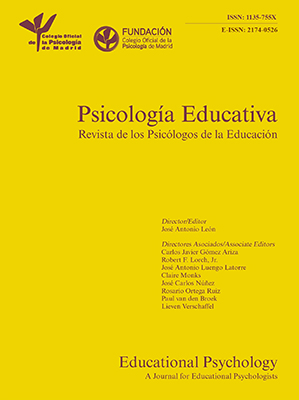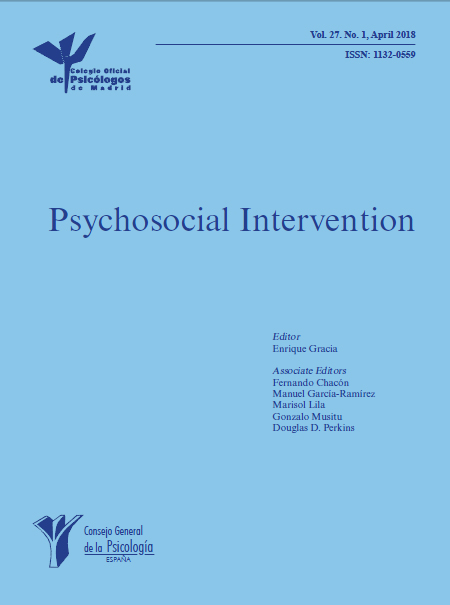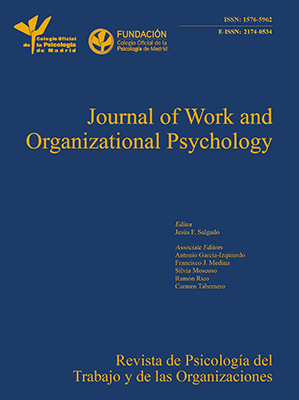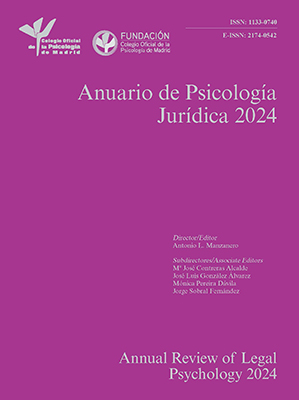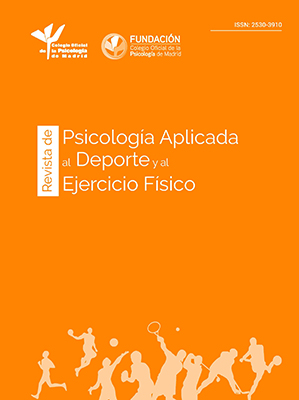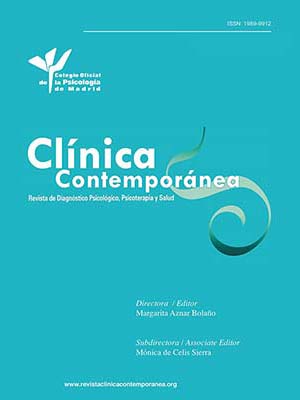
Romantic Attachment and Cognitive-Emotional Regulation in Psychological Maladjustment
[El apego romántico y la regulación emocional-cognitiva en la desadaptación psicológica]
Alicia Mena, Begoña Delgado, Miguel A. Carrasco, & Francisco P. Holgado-Tello
Faculty of Psychology, National University of Distance Education (UNED), Spain
https://doi.org/10.5093/clh2025a9
Received 3 September 2024, Accepted 26 February 2025
Abstract
Background: This study aims to explore the effects of romantic attachment and cognitive strategies of emotional regulation on symptoms of psychological maladjustment, depression, and anxiety. Specifically, this study explores the ways in which these factors affect the mental health of women and men. Method: 360 adults (ages 18-81, 73% women, M = 41.45 years old) completed the Spanish-language versions of the Close Relationship Experiences Questionnaire (ECR-R), the Cognitive Emotion Regulation Questionnaire (CERQ), and the Symptom Assessment Questionnaire-45 (SA-45). Results:The mediational analysis performed through path analysis showed that romantic anxiety is significantly related to psychological maladjustment and depression both directly and through its impact on the selection of less adaptive cognitive strategies for emotional regulation. Avoidance played a relevant role among men, associated with a significant decrease in the most adaptive regulation strategies, which affected their levels of maladjustment and depression. Conclusions: These results highlighted the need to consider specific patterns of relationships between the romantic bond and means of cognitive emotional regulation. Such considerations should include sex and type of psychological distress, which can, in turn, facilitate the design of specific interventions.
Resumen
Antecedentes: Este estudio pretende explorar los efectos del apego romántico y de las estrategias cognitivas adaptativas y menos adaptativas de la regulación emocional sobre el malestar psicológico, la depresión y la ansiedad. Específicamente, este estudio explora las vías en que estos factores afectan a la salud mental de las mujeres y los hombres.Método:Una muestra de 360 participantes (de 18 a 81 años, M = 41.45 años, el 73% mujeres) cumplimentó las versiones en español del Close Relationship Experiences Questionnaire (ECR-R), el Cognitive Emotion Regulation Questionnaire (CERQ) y el Symptom Assessment Questionnaire-45 (SA-45).Resultados: El análisis de mediación mostró que la ansiedad romántica está significativamente relacionada con el malestar psicológico y la depresión, ya sea directamente o mediante el uso de estrategias cognitivas de regulación emocional menos adaptativas. La evitación jugó un papel relevante en los hombres, asociada a una disminución significativa de las estrategias de regulación más adaptativas, lo que afectó a sus niveles de malestar psicológico y depresión. Conclusiones:Estos resultados ponen de manifiesto la necesidad de considerar patrones específicos de relación entre el vínculo romántico y la regulación emocional en función del género y del tipo de malestar psicológico analizado, lo que a su vez puede facilitar el diseño de intervenciones específicas.
Palabras clave
Apego, RegulaciĂłn emocional cognitiva, AdaptaciĂłn psicolĂłgica, DepresiĂłn, Ansiedad, Diferencias sexualesKeywords
Attachment, Cognitive-emotional regulation, Psychological maladjustment, Depression, Anxiety, Sex differencesCite this article as: Mena, A., Delgado, B., Carrasco, M. A., & Holgado-Tello, F. P. (2025). Romantic Attachment and Cognitive-Emotional Regulation in Psychological Maladjustment. Clinical and Health, 36(3), 125 - 133. https://doi.org/10.5093/clh2025a9
Correspondence: bdelgado@psi.uned.es (B. Delgado).For human beings, it is essential to build and maintain stable emotional bonds that provide support and security. For decades, the principles of Bowlby’s theory of primary affective bonding have been found to be useful for describing affective styles in the framework of adult relationships (Bowlby, 1982). Although romantic bonds have specific characteristics, such as the affective contact allowed by sexual relations, romantic attachment represents a stable emotional bond that is based on trust with the reference figure and the maintenance of security with said figure. From this perspective, Bartholomew and Horowitz (1991)—combining the dimensions of avoidance and anxiety—described different patterns of adult interactions consistent with traditional attachment styles: secure (low anxiety and low avoidance), worried (high anxiety and low avoidance), distant or avoidant (low anxiety and high avoidance), and fearful-avoidant (high anxiety and high avoidance). According to these patterns, people with secure attachment to their partners exhibit more capacity for integration with the other as well as greater interest in satisfying their needs (Brassard et al., 2012). In contrast, people with anxious romantic attachment tend to feel insecure about the other’s interest and commitment (Campbell et al., 2005). On the other hand, avoidant attachment to one’s partner is associated with lower levels of commitment, a greater tendency to distance and isolate in the face of conflicts, and higher acceptance of infidelity (Feeney, 2008; Mikulincer & Shaver, 2016; Swets & Cox, 2023). Romantic attachment has been shown to have an important impact on aspects of psychological adjustment, both within and outside the realm of life as a couple. People who maintain a secure bond with their partners have greater subjective well-being and life satisfaction (Chen et al., 2022; Homan, 2018; Marrero-Quevedo et al., 2019). In addition, they express greater sexual motivation toward their partners and exhibit an ability to integrate sexuality with affection (Brassard et al., 2012). Conversely, anxious bonding with a partner is more associated with symptoms of depression and low self-esteem (Dagan et al., 2018; Mikulincer & Shaver, 2016). In addition, people who are anxiously attached to their partners also tend to experience more jealousy and conflict (Richter et al., 2022). Likewise, unsecure attached people use to report less sexual satisfaction (Blumenstock, 2023; Candel & Turliuc, 2019; Rogier et al., 2024; Tatum et al., 2023). Findings from psychopathology have also shown that anxious attachment is a risk factor for secondary psychopathic traits (those influenced by environmental factors), while avoidant attachment is a risk factor for primary psychopathic traits (Kyranides & Neofytou, 2021), such as emotional detachment, lack of empathy, shallow affect, and interpersonal manipulation rooted in genetic or biological predispositions. Results like these demonstrate that romantic attachment occupies a privileged position in the explanation of people’s social and emotional behavior. The relationships between romantic bonding and psychological maladjustment have received special attention from the perspective of emotional regulation. Initial research on romantic attachment from this point of view highlighted the tendency toward over-activation of the attachment system in people with anxious attachment, who exhibited an ongoing state of over-vigilance in the face of potential threats as well as repeated attempts to maintain contact with their partners. In contrast, people with avoidant attachments tend to maintain an inactive attachment model (Cassidy & Kobak, 1988; Mikulincer & Shaver, 2016), highlighting that the strategy of neglecting emotionally relevant information could function at a pre-conscious or “preventive” level (Fraley, Gardner, et al., 2000; Mikulincer & Shaver, 2016). The inclination toward the suppression of emotions in avoidant individuals and the tendency toward emotional dysregulation in anxious individuals have both been repeatedly supported by evidence (Ávila et al., 2015; Clear et al., 2020). The influence of attachment on emotional regulation has also motivated multiple studies aimed at understanding how romantic attachment styles and emotional regulation processes interact in the triggering of psychological maladjustment. In this regard, it has been found that the relationship between anxious attachment and various negative aspects of physical and mental health is partially explained by a lack of emotional awareness and limited access to emotion regulation strategies (Lewczuk et al., 2021). Clear et al. (2020) found that anxious attachment facilitates the appearance of symptoms of depression and social anxiety, both directly and through its effect on the dysregulation of emotions like anger or sadness. Similarly, the relationship between anxious attachment and psychological well-being appears to be mediated by personal beliefs about the ability to self-regulate feelings (Mónaco et al., 2021). Ávila et al. (2015) also pointed out that rumination, communication, and emotional regulation are crucial factors when it comes to interpreting the relationship between a romantic attachment style and adaptation to breast cancer treatment. Avoidant bonding has been shown to have less substantial consequences for mental health indicators, although its relationship with maladaptive psychological functioning is evident. For example, Clear et al. (2020) revealed that avoidant attachment, although it did not have mediating effects, was associated with depression and social anxiety and facilitated the suppression of emotions—in line with a general deactivation strategy. In addition, Brandão et al. (2023) found that rumination and emotional communication mediate the relationship between emotional invalidation and depression in people with high levels of avoidance. In the same vein, a meta-analysis by Malik et al. (2015) confirmed that anxious attachment—and to a lesser extent avoidant attachment—is significantly related to both emotional regulation and depression. Evidently, mediation studies have identified many of the emotional processes that channel the influence of romantic attachment toward different aspects of well-being or psychological maladjustment, especially symptoms of anxiety and depression. However, there remains a lack of studies specifically analyzing the mediating contribution of cognitive strategies to emotional regulation. In this context, the role of thoughts as steps prior to regulatory action has been emphasized (Garnefski et al., 2001; Garnefski et al., 2002). The distinction between adaptive and maladaptive cognitive emotion regulation strategies (Garnefski et al., 2001) is known to have important clinical utility. Multiple researchers have found that maladaptive strategies, such as catastrophizing, rumination, self-blame, and blaming others, are associated with higher levels of depression and anxiety, while cognitive strategies such as re-planning, acceptance, focusing on the positive, and re-evaluation are not only negatively associated with these same symptoms but also positively related to aspects like self-esteem (Domaradzka & Fajkowska, 2018; Doron et al., 2013; Garnefski & Kraaij, 2006; Garnefski et al., 2002; Holgado-Tello et al., 2018; Kharwar & Singh, 2024; Martin & Dahlen, 2005; Yano & Oishi, 2024). However, to our knowledge, the implications of these two groups of cognitive regulation strategies (adaptive and non-adaptive) in relation to romantic attachment and symptoms of psychological maladjustment have not been assessed. Thus, this study aims to examine the relationship between romantic bonding, adaptive and non-adaptive cognitive emotion regulation strategies, and symptoms of psychological maladjustment—including the symptoms of depression and anxiety given their high prevalence in the population and, congruently, their recurrence in studies on emotional regulation (Domaradzka & Fajkowska, 2018; Garnefski & Kraaij, 2018; Holgado-Tello et al. 2018; Messina et al., 2023; Monin et al., 2020; Somerville et al., 2024; Zimmer-Gembeck & Skinner, 2016). Previous studies have shown that women tend to have higher levels of anxiety and depression (Altemus et al., 2014; Nolen-Hoeksema, 2012), as well as a greater tendency to internalize emotional coping and a greater inclination to rumination (Duarte et al., 2015; Johnson & Whisman, 2013; Nolen-Hoeksema, 2012; Nolen-Hoeksema & Aldao, 2011; Wang et al., 2021; Zlomke & Hahn, 2010). For this reason, we consider it relevant that the objectives of this mediation study are analyzed according to sex. Based on previous studies, it is expected that anxious bonding is more robustly associated with symptoms of psychological maladjustment, anxiety, and depression as well as with less adaptive regulation strategies (Hypothesis 1). It is also expected that less adaptive regulation strategies are more relevant than adaptive strategies in cases of anxiety and depression (Hypothesis 2). Sex-dependent effects—which point to potential vulnerabilities that may be more characteristic of men or women—are also expected. More specifically, in relation to symptoms of anxiety and depression, the mediating role of maladaptive regulatory strategies is hypothesized to be higher in women (Hypothesis 3). Finally, with regard to avoidant or anxious attachment dimensions, no sex differences are presumed (Hypothesis 4). Although there is some evidence of a bias that makes anxious attachment more prevalent in women and avoidant attachment more prevalent in men (Del Giudice, 2011), sex differences in attachment have not been systematically uncovered (Guzmán-González et al., 2023; Scharfe, 2016). Hopefully, the results of this research help to clarify the roles played by adaptive and less adaptive strategies in the relationship between insecure romantic attachment and symptoms of psychological maladjustment, depression, or anxiety and point to possible relevant interventions to manage those strategies. Sample Participants were selected in a non-probabilistic manner using a combination of convenience and voluntary sampling. The final sample consisted of 360 adults (73% women, 27% men) aged between 18 and 81 years (M = 41.45 years). About 15% were under 26 years of age, 46% were between 26 and 45 years of age, 34% were between 46 and 65 years of age, and 5% were over 66 years of age. All the participants live in Spain, and most of them were Spanish people (85.2%), but also there were participants from Latin America (11.9%) or elsewhere in Europe (2.4%). The participants were recruited from the general population through dissemination via advertisements and social networks. The inclusion criteria required participants to be of legal age and willing to participate in the study. Instruments Sociodemographic variables, including age, sex, and nationality, were collected using an ad hoc data collection sheet specifically designed for this study. In addition, standardized instruments were employed to assess the primary variables under investigation. Dimensions of romantic attachment were assessed using the Questionnaire of Experiences in Close Relationships (ECR-R; Fraley, Waller, et al., 2000; reduced version and validated in Spanish by Fernández-Fuertes et al., 2011). This questionnaire measures two dimensions of romantic attachment—anxiety and avoidance—on an 18-item Likert scale with seven possible responses (1 = strongly disagree, 7 = strongly agree). The ECR-R has demonstrated good reliability and psychometric validity in various studies, with internal consistency values (Cronbach’s alpha) ranging from .80 to .94 for the two sub-scales of the questionnaire (anxiety and avoidance); it also shows good test-retest reliability over time (Fraley et al., 2006; Wei et al., 2007). The reliability of the avoidant scale and the anxiety scale was measured using McDonald’s ω and Cronbach’s α (.88 and .87 for the avoidant scale, .90 and .89 for the anxiety scale, respectively). Cognitive strategies for emotional regulation were evaluated using the Cognitive Emotion Regulation Questionnaire (CERQ-27; Holgado-Tello et al., 2018), which is a shortened Spanish version of 27 items of the original CERQ questionnaire by Garnefski et al. (2001). This is a self-administered questionnaire that assesses the main cognitive strategies of emotional regulation–namely self-blame, acceptance, rumination, positive focusing, planning, reevaluation, perspective-taking, catastrophizing, and blaming others–with responses ranging from 1 (almost never) to 5 (almost always). The CERQ has good psychometric properties, with internal consistency in each subscale established by Cronbach’s alpha values between .68 and .81 for its original version (Garnefski et al., 2001) and between .74 and .88 for the Spanish version (Holgado-Tello et al., 2018). In this study, we used the global measures of adaptive (CERQ+) and less adaptive (CERQ-) cognitive-emotional regulation strategies. The reliability values for the sample were as follows: ω = .86 and α = .86 for CERQ+; ω = .75 and α = .77 for CERQ-. The Symptom Assessment Questionnaire-45 (SA-45; Davison et al., 1997; reduced and validated version in Spanish by Sandín et al., 2008) is a 45-item self-applied instrument that assesses patterns of symptoms present in individuals during the preceding week along a Likert scale ranging from 0 (not at all) to 4 (a lot or extremely). Notably, this questionnaire distinguishes between the dimensions of somatization, obsession-compulsion, interpersonal sensitivity, depression, anxiety, hostility, phobic anxiety, paranoid ideation, and psychoticism. The Spanish version has a total reliability of .95, exhibiting a Cronbach’s alpha coefficient above .80 for each scale aside from psychoticism (.70) (Sandín et al., 2008). For the purposes of this investigation, only three measures were applied: Psychological Maladjustment (ω = .96, α = .95), Anxiety (ω = .87, α = .84), and Depression (ω = .87, α = .86). Procedure This study received authorization from the ethics committee of the National University of Distance Education (UNED) [11-SISH-PSI-2023]. All participants signed an informed consent form. All ethical principles and current regulations related to the voluntary nature of research and the right to information, confidentiality, and data protection were complied with. Data collection was carried out from June 2023 to March 2024 using a battery (developed with the Qualtrics© tool) of questionnaires that included questions on socio-demographic data and study-specific variables. Study Design and Data Analysis This study employs an ex post facto cross-sectional design in which no variables were manipulated. First, a descriptive analysis of the variables was conducted, followed by mean comparisons between sexes using Student’s t-test and correlation analyses among the variables. Next, mediation effects were examined through path analysis (Baron & Kenny, 1986; Holgado-Tello et al., 2019), with the dimensions of the ECR serving as predictors, the dimensions of the CERQ serving as mediators, and psychological maladjustments serving as the outcome variables. Finally, the moderating role of sex was analyzed through multigroup comparisons using structural equation modeling. The statistical packages SPSS 27 and LISREL 8.8 were used to conduct all these analyses (Jöreskog & Sörbom, 1996). Descriptive Analyses: Analysis of Correlations and Differences by Sex The descriptive statistics are presented in Table 1. Mean differences by sex suggest significantly higher levels of the dimensions of anxiety and depression (p < .05), psychological maladjustment (p = .007) and less adaptive emotion regulation strategies (CERQ-) (p = .009) among women. Notably, however, there were no significant differences in the anxious or avoidant attachment dimensions (p = .123, p = .344 respectively) or in the use of more adaptive emotion regulation strategies (CERQ+). Table 1 Descriptive Statistics   Note. ECR_Anxiety = anxiety dimension of the Questionnaire of Experiences in Close Relationships; ECR_Avoidance = avoidance dimension of the Questionnaire of Experiences in Close Relationships; CERQ+ = adaptive strategies of the Cognitive Emotion Regulation Questionnaire; CERQ- = less adaptive strategies of the Cognitive Emotion Regulation Questionnaire; Psy. Maladjustment = global score of the Symptom Assessment Questionnaire-45; Anxiety = anxiety dimension of the Symptom Assessment Questionnaire-45; Depression = depression dimension of the Symptom Assessment Questionnaire-45. *p < .05, **p < .01. The results of the analysis of the correlations between the variables in the total sample and sex are presented in Table 2. In the total sample, anxious attachment is negatively related to the most adaptive emotion regulation strategies (CERQ+) and positively related to avoidant attachment as well as to psychological maladjustment, anxiety, and depression. In addition, adaptive and less adaptive emotion regulation strategies are inversely related. Table 2 Correlations between Variables for the Total Sample and Divided by Sex   Note. Above the diagonal are the correlations for the total sample. Below the diagonal and outside the parentheses are the values for men; values below the diagonal and inside the parentheses are the values for women. ECR_Anxiety = anxiety dimension of the Questionnaire of Experiences in Close Relationships; ECR_Avoidance = avoidance dimension of the Questionnaire of Experiences in Close Relationships; CERQ+ = adaptive strategies of the Cognitive Emotion Regulation Questionnaire; CERQ- = less adaptive strategies of the Cognitive Emotion Regulation Questionnaire; Psy.Maladjustment = global score of the Symptom Assessment Questionnaire-45; Anxiety = anxiety dimension of the Symptom Assessment Questionnaire-45; Depression = aepression dimension of the Symptom Assessment Questionnaire-45. *p < .05, **p < .01. When dividing the sample by sex, changes in correlations were observed. Some associations remained significant across both groups, but others (e.g., attachment anxiety, attachment avoidance) were only significant among men. Correlations between the adaptive and maladaptive emotion regulation strategies were stronger among men. However, correlations between anxiety, psychological adjustment, and depression were significant for both sexes, though they were stronger among women. Direct and Mediated Relationships between Attachment Dimensions, Cognitive Strategies of Emotional Regulation, and Psychological Maladjustment Figure 1 represents model 1, in which cognitive strategies for emotional regulation (CERQ+ and CERQ-) were explored as mediating variables with psychological maladjustment as a criterion variable. The main global fit indices for this model were chi-square = 0.02 (df = 3, p = .99), root mean square error of approximation (RMSEA) = .00, and standardized root mean square residual (SRMR) = .001, indicating a good fit. Figure 1 Model 1 Mediation in the Total Sample  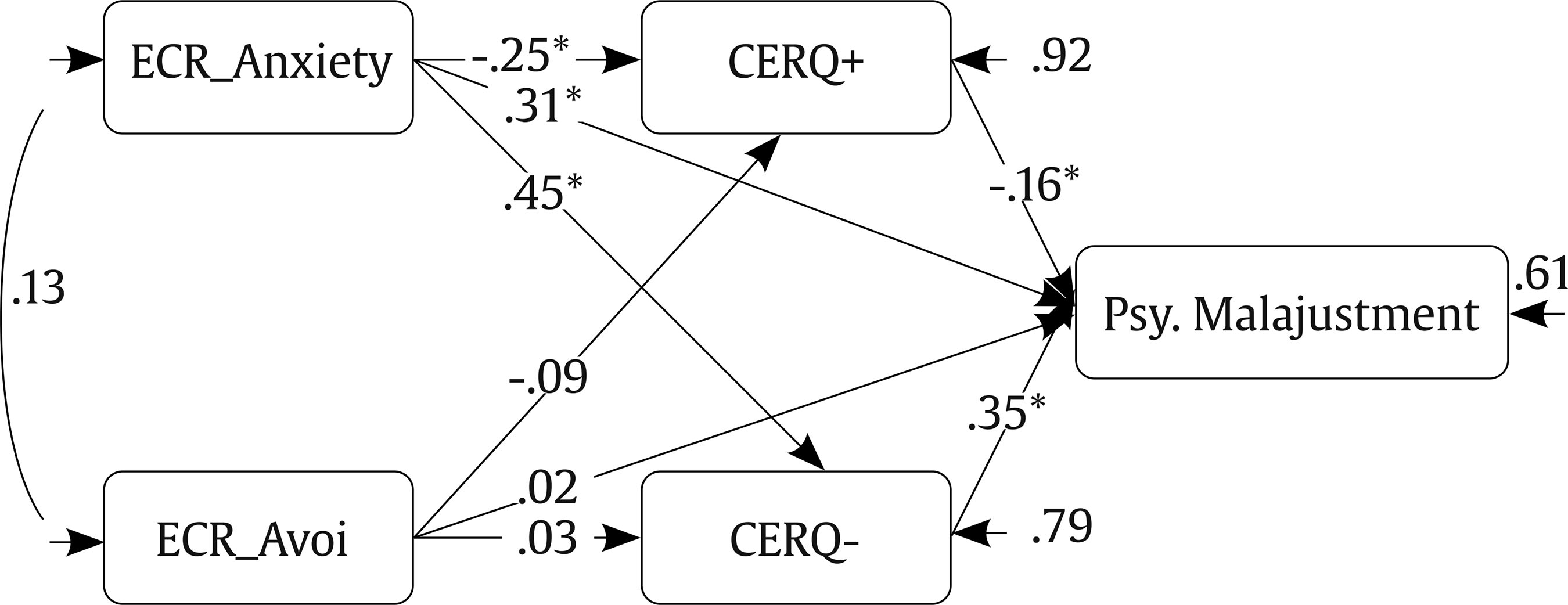 Note. ECR_Anxiety = Anxiety dimension of the Questionnaire of Experiences in Close Relationships; ECR_Avoi = avoidance dimension of the Questionnaire of Experiences in Close Relationships; CERQ+ = adaptive strategies of the Cognitive Emotion Regulation Questionnaire; CERQ- = less adaptive strategies of the Cognitive Emotion Regulation Questionnaire; Psy.Maladjustment = global score of the Symptom Assessment Questionnaire-45. *p < .05. As shown in Figure 1, the relationship between adult attachment and psychological maladjustment is significantly mediated by emotion regulation strategies, especially when it comes to the relationship between anxious attachment and psychological maladjustment. Only the indirect effect of ECR_anxiety to maladjustment through both mediating variables was found to be significant (c = .20, CR = 6.46), while the direct effect remained significant (c = .31, CR = 6.40), suggesting partial mediation of ECR_anxiety. Anxious attachment increases maladjustment and is negatively related to the use of more adaptive emotion regulation strategies, which in turn are negatively related to maladjustment. Avoidance is not relevant. The direct and indirect effects of the model are shown in Table 3. Table 3 Total an Indirect Effect of Model 1 on the Total Sample and by Sex   Note. The effects for men and women are shown in parentheses (men/women). ECR_Anxiety = anxiety dimension of the Questionnaire of Experiences in Close Relationships; ECR_Avoidance = avoidance dimension of the Questionnaire of Experiences in Close Relationships; CERQ+ = adaptive strategies of the Cognitive Emotion Regulation Questionnaire; CERQ- = less adaptive strategies of the Cognitive Emotion Regulation Questionnaire; Psy.Maladjustment = global score of the Symptom Assessment Questionnaire-45; Anxiety = anxiety dimension of the Symptom Assessment Questionnaire-45; Depression = depression dimension of the Symptom Assessment Questionnaire-45. *p < .05. To explore whether the proposed mediation model is sex-invariant, a multi-group analysis was conducted. The Moderating Effect of Sex for Model 1 Figure 2 shows the model for men and women. The fit indices for men were as follows: χ2 = 1.61 (p = .68, df = 3); RMSEA = .00; SRMR = .03. For women, they were as follows: χ2 = .27 (p = .97, df = 3); RMSEA = .00; SRMR = .01. These results indicate that the model fits well across both groups. Considering both groups simultaneously, the adjustment indices—χ2 = 1.88 (p = .93, df = 6); RMSEA = .00; SRMR = .01—suggest that the structure of the model is consistent across men and women. Figure 2 Model 1 for Men and Women.  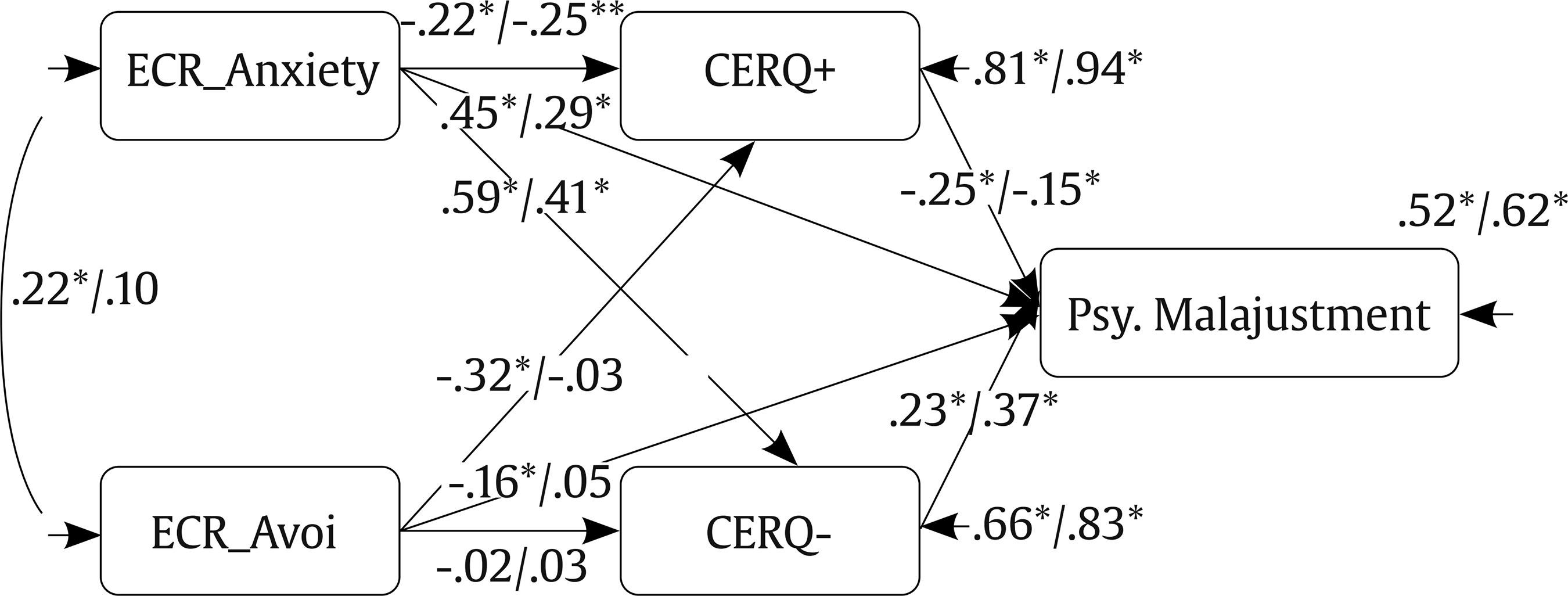 Note. Men/women, ECR_Anxiety = anxiety dimension of the Questionnaire of Experiences in Close Relationships; ECR_Avoi = avoidance dimension of the Questionnaire of Experiences in Close Relationships; CERQ+ = adaptive strategies of the Cognitive Emotion Regulation Questionnaire; CERQ- = less adaptive strategies of the Cognitive Emotion Regulation Questionnaire; Psy.Maladjustment = global score of the Symptom Assessment Questionnaire-45. *p < .05. Descriptively, among both women and men, psychological maladjustment is related to anxiety in their romantic relationships; the greater the anxiety, the greater the maladjustment, the greater the use of maladaptive regulation strategies, and the lower the use of adaptive strategies, increasing psychological maladjustment (Figure 2). In men, both anxiety and avoidance affect psychological adjustment, but avoidance slightly decreases maladjustment. The relationship between ECR_Avoidance and CERQ+ is variable between the sexes: Among men, it is -.32; Among women, it is -.03. With respect to the comparison model, the restriction of equality between both parameters led to a significant increase in chi-square (Λχ2 =13.89; Λdf = 6, p = .03), indicating that avoidance is more heavily associated with less frequent use of adaptive emotion regulation strategies among men than among women. Direct and Mediating Relationships between Attachment Dimensions, Cognitive Strategies of Emotional Regulation, Depression, and Anxiety The second model (Model 2) included emotion regulation strategies as mediators and included depression and anxiety (from SA45) as criterion variables (Figure 3). The global fit indices were excellent: chi-square = .015 (df = 3, p = .99); RMSEA = .00; SRMR =. 001. The indirect effects of ECR_Anxiety on anxiety and depression of SA45 were significant (SA_Anxiety: c = .19, CR = 5.96; SA_Depression: c = .19, CR = 6.42), while the effects for ECR_Avoidance were not. As in model 1, emotional regulation exhibits a partial mediation with respect to ECR_Anxiety. Figure 3 indicates that anxious attachment is associated with greater anxiety and depression (SA45 directly and indirectly through both cognitive emotion regulation strategies). Figure 3 Model 2.  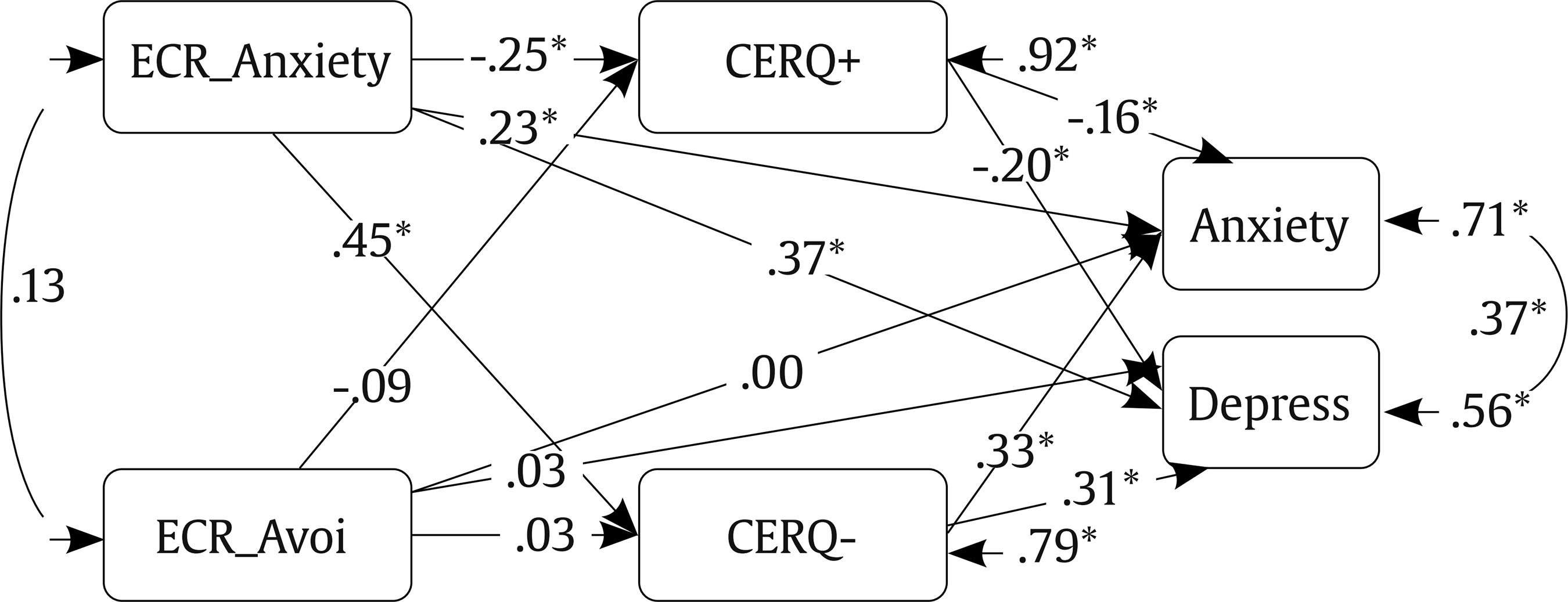 Note. ECR_Anxiety = anxiety dimension of the Questionnaire of Experiences in Close Relationships; ECR_Avoi = avoidance dimension of the Questionnaire of Experiences in Close Relationships; CERQ+ = adaptive strategies of the Cognitive Emotion Regulation Questionnaire; CERQ- = less adaptive strategies of the Cognitive Emotion Regulation Questionnaire; Anxiety = anxiety dimension of the Symptom Assessment Questionnaire-45; Depress = depression dimension of the Symptom Assessment Questionnaire-45. *p < .05. The direct and indirect effects of the model are shown in Table 4. Table 4 Total and Indirect Effects of Model 2 on the Total Sample and by Sex   Note. The effects for men and women are shown in parentheses (men/women ECR_Anxiety = anxiety dimension of the Questionnaire of Experiences in Close Relationships; ECR_Avoidance = avoidance dimension of the Questionnaire of Experiences in Close Relationships; CERQ+ = adaptive strategies of the Cognitive Emotion Regulation Questionnaire; CERQ- = less adaptive strategies of the Cognitive Emotion Regulation Questionnaire; Psy.Maladjustment = global score of the Symptom Assessment Questionnaire-45; Anxiety = anxiety dimension of the Symptom Assessment Questionnaire-45; Depression = depression dimension of the Symptom Assessment Questionnaire-45. *p < .05. The Moderating Effect of Sex for Model 2 Figure 4 shows model 2 for men and women. Fit indices were good for men (χ2 = 1.64, p = .65, df = 3; RMSEA = .00; SRMR = .02), for women (χ2 = .27, p = .96, df = 3; RMSEA = .00; SRMR = .01), and for both groups simultaneously (χ2 = 3.90, p = .69, df = 6; RMSEA = .00; SRMR = .01). Figure 4 Model 2 for Men and Women.  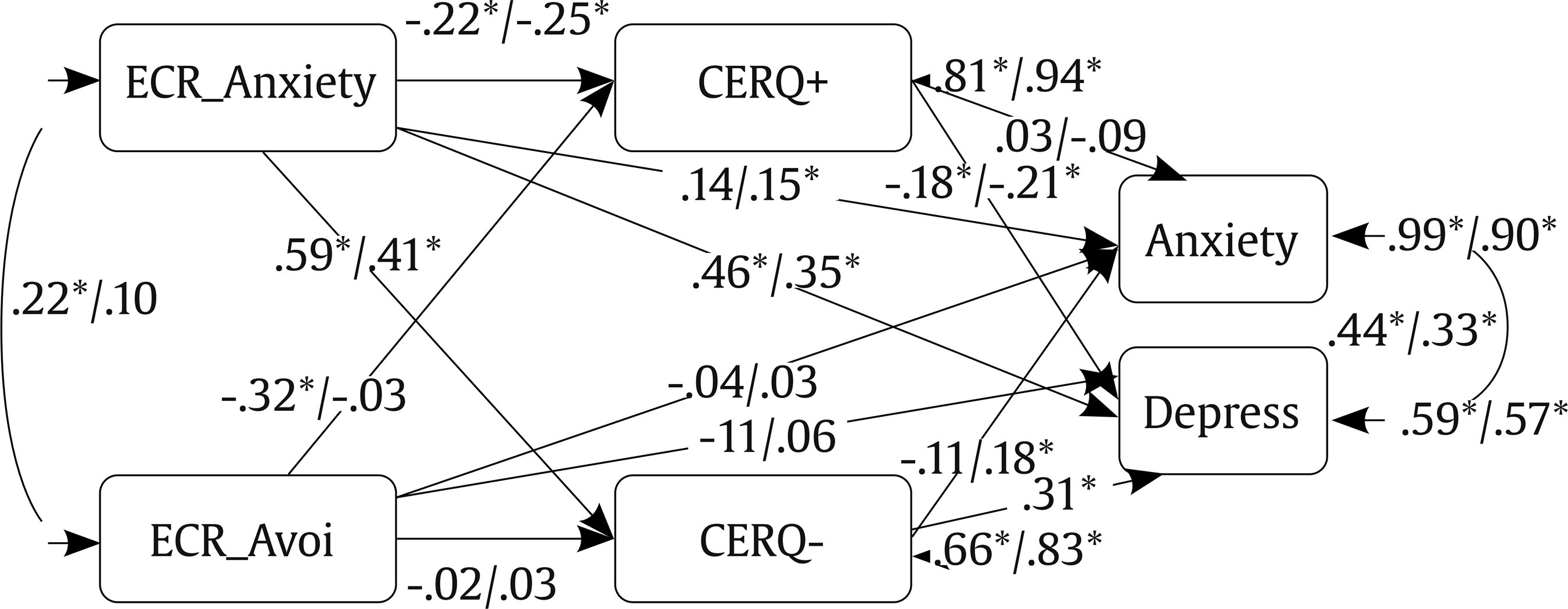 Note. Men/Women. ECR_Anxiety = anxiety dimension of the Questionnaire of Experiences in Close Relationships; ECR_Avoi = avoidance dimension of the Questionnaire of Experiences in Close Relationships; CERQ+ = adaptive strategies of the Cognitive Emotion Regulation Questionnaire; CERQ- = less adaptive strategies of the Cognitive Emotion Regulation Questionnaire; Anxiety = anxiety dimension of the Symptom Assessment Questionnaire-45; Depress = depression dimension of the Symptom Assessment Questionnaire-45. *p < .05. Descriptively, the results indicate that the structure of the model does not vary significantly by sex (Figure 4). More specifically, a higher level of anxiety toward one’s partner (ECR_Anxiety) is related to the less frequent use of adaptive cognitive emotion regulation strategies and more frequent use of less adaptive or maladaptive cognitive emotion regulation strategies, which contribute to the onset of depressive symptoms. Among women, anxiety about romantic relationships (ECR_Anxiety) is directly associated with symptoms of anxiety (SA45) and indirectly associated with the more frequent use of less adaptive strategies. In this case, three variant parameters were found between the sexes, specifically in the following relationships: a) ECR_anxiety and anxiety (SA45) (Λχ2 =12.08, Λdf = 5, p = .03); b) ECR_avoidance and CERQ+ (Λχ2 = 24.39, Λdf = 9, p < .01); and c) ECR_anxiety and CERQ- (Λχ2 = 18.57; Λdf = 9, p = .03). The most striking difference is between ECR_avoidance and CERQ+. Among men, the higher ECR_avoidance is, the lower their use of more adaptive strategies; however, this relationship is irrelevant among women. Important evidence indicates that romantic bonding with a partner is a relevant factor in explanations of adults’ psychological functioning; the importance of anxious attachment in different aspects of mental health has been especially highlighted, either directly or indirectly through its effect on emotional dysregulation (Clear et al., 2020; Jinyao et al., 2012; Lewczuk et al., 2021). In this context, the aim of this study was to explore the relationship between romantic attachment and psychological maladjustment, anxiety, and depression by considering the use of adaptive and maladaptive cognitive-emotion regulation strategies as well as examining potential sex-based differences in these dynamics. The analyzed models underline the direct contribution of anxious attachment to psychological maladjustment and depression as well as the use of cognitive strategies of emotional regulation (both adaptive and maladaptive). These associations confirm that anxious bonding is a decisive factor in the emotional functioning of adults (Hypothesis 1), as it has been already pointed out (Malik et al., 2015; Mónaco et al., 2021). In the case of this research (and in line with the first hypothesis), the results show that anxious attachment is significantly associated with symptoms of maladjustment and depression through both direct and mediated relationships. These relationships indicate that the more present the anxious attachment, the greater the presence of symptoms of psychological maladjustment (see Figures 1 and 2) and depressive symptoms (see Figures 3 and 4). At the same time, anxious attachment drives the use of less adaptive cognitive emotion regulation strategies while limiting the use of more adaptive strategies, giving way to symptoms of psychological maladjustment and depression. These results, shared across both men and women, are consistent with previous research and reinforce the negative influence of anxious attachment on mental health and emotional regulation (Clear & Zimmer-Gembeck, 2017; Lewczuk et al., 2021). These findings provide a more detailed and specific understanding of how anxious attachment influences mental health, revealing not only its direct impact on psychological maladjustment and depression but also its ability to unbalance patterns of cognitive emotion regulation strategies and strengthen the prevalence of detrimental strategies (e.g., rumination, catastrophizing, self-blaming, blaming others). In line with previous research, avoidance exhibited more discrete and specific effects (Gökda, 2021; Zhang et al. 2022; Zheng et al, 2020). Among men, avoidant attachment was associated with a decrease in symptoms of psychological maladjustment as well as a severe decrease in adaptive regulation strategies, which in turn favored symptoms of psychological maladjustment and depression. The analyzed models also offer some relevant insights into differences between sexes. On the one hand, among women anxious attachment is also associated with symptoms of anxiety, both directly and indirectly through the activation of less adaptive cognitive regulation strategies. This effect, found among women, may be subject to some contextual explanation, as most cultures promote heightened awareness among women of the care and maintenance offered by affective bonds (Bedrov & Gable, 2023; Eisenberg, 2004). Therefore, it is possible among women that the fear of a breakup with a partner causes higher levels of general anxiety, given that such a breakup of the romantic bond may cause them to face greater emotional, personal, and social challenges. On the other hand, avoidance only had significant effects among men, where it reduced psychological maladjustment but (across the two models analyzed) was accompanied by a severe deactivation of the most adaptive emotion regulation strategies, giving way to symptoms of psychological maladjustment and depression. These concurrent circumstances support the possibility that avoidant attachment among men may mitigate symptoms of psychological maladjustment by reducing the risk of having to face complex affective situations without sufficient support from adaptive strategies of emotional regulation. This aligns with existing evidence showing people with avoidant attachment often rely on “deactivation strategies” to halt further emotional distress, essentially coping with emotion through suppression and repression. This mechanism may protect against overwhelming emotional scenarios but also perpetuate challenges in emotional awareness, emotional intelligence, and interpersonal relationships (Mikulincer et al., 2003; Simpson & Rholes, 2017; Stevens, 2017; Uccula et al., 2023). Additionally, this strategy can lead to lower emotional flexibility and struggles with adapting to evolving environments. In this regard, avoidant attachment has often been linked to less effective patterns of emotional regulation that prioritize avoidance over confrontation with distressing emotions or situations. This may create a short-term buffer against psychological maladjustment but can limit the development of adaptive emotional coping strategies in the long term (Mikulincer et al., 2003; Stevens, 2017). If this interpretation is correct, we may be facing a complex panorama—one that has already been revealed in other research—that warns against the use of a priori interpretations. For example, Ávila et al. (2015) highlighted as a singular effect that women with anxious attachment performed better in follow-ups for breast cancer treatment, which they attributed to over-vigilance with regard to symptoms. In addition, Rapoza et al. (2016) found that individuals with high levels of avoidance were practically insensitive to the negative effects of a lack of social support for their physical well-being. From a clinical perspective, it would be desirable to prevent the negative relationship between avoidance and adaptive cognitive regulation from being perpetuated, keeping avoidance from being established as a protective factor if it is perceived by some men as a valid strategy for inhibiting psychological maladjustment. In summary, romantic bonding and cognitive emotional regulation are confirmed to be two relevant constructs when explaining symptoms of psychological maladjustment and depression. The effects associated with anxiety about romantic bonds manifested directly in both the measures of general maladjustment and depression as well as the specific case of women experiencing symptoms of anxiety. Indirect effects were also observed, revealing that in the context of the over-activation of the attachment system anxious individuals fundamentally resort to the use of maladaptive cognitive regulatory strategies, such as rumination, self-blame, blaming others, and catastrophizing (all of which increase or exacerbate the symptoms of psychological maladjustment and depression), opting to avoid more adaptive cognitive elaborations. Avoidant attachment effects were also identified, though they were limited to men. Thus, in line with our predictions, anxious bonding was more robustly associated with symptoms of psychological maladjustment, anxiety, and depression as well as with less adaptive regulation strategies than avoidant bonding (Hypothesis 1). This also aligns with previous research emphasizing the greater influence of anxious attachment on psychological distress (Gökda, 2021; Malik et al. 2015; Zhang et al. 2022; Zheng et al, 2020). As hypothesized, less adaptive regulation strategies became more relevant than adaptive ones (Hypothesis 2). More specifically, less adaptive regulation strategies were activated to a larger degree by anxious attachment than adaptive strategies were deactivated; moreover, less adaptive strategies affected the frequency of symptoms of psychological maladjustment, anxiety, and depression to a higher degree than adaptive strategies. Therefore, the results also contribute to reinforcing the recognized significance of maladaptive strategies in psychological distress (Holgado-Tello et al., 2018; Nolen-Hoeksema & Aldao, 2011; Yano & Oishi, 2024). Concerning gender differences, there were no significant differences between women and men when it came to the dimensions of anxiety or avoidant attachment (Hypothesis 4). However, as predicted, maladaptive regulatory strategies played a more relevant role among women (Hypothesis 3). Women used more maladaptive regulatory strategies than men and showed higher levels of psychological maladjustment, anxiety, and depression. More specifically anxious attachment among women increased the prevalence of symptoms of anxiety, primarily through an indirect pathway involving a heightened use of maladaptive strategies. These findings align with prior research showing higher levels of anxiety, depression, rumination, and internalized emotional coping among women (Altemus et al., 2014; Duarte et al., 2015; Nolen-Hoeksema, 2012; Wang et al., 2021). In contrast, romantic avoidance among men significantly inhibited their use of adaptive cognitive-emotional regulation strategies, which some authors consider the most critical factor when it comes to differentiating between individuals’ cognitive regulation styles (Delgado et al., 2023). Therefore, avoidant attachment indirectly increases symptoms of depression and psychological maladjustment in men. Further research is needed to clarify this effect. As an initial explanation, it is possible that the contextual factors that promote the care and maintenance of affective relationships among women (Bedrov & Gable, 2023; Eisenberg, 2004) may lead avoidant men—more than women—to not be particularly engaging in social interactions, limiting their opportunities to develop adaptive emotion regulation strategies. However, additional studies are necessary to explore further this phenomenon. Interestingly, avoidant attachment appeared to protect men from symptoms of psychological maladjustment unrelated to depression and anxiety. The inverse relationship between avoidant attachment and psychological maladjustment might suggest that avoidance shields men from failed and tumultuous interpersonal exchanges, which could otherwise stem from ineffective emotional regulation. The study underlines the need to consider unique trajectories of influence between romantic bonds and emotional regulation depending on gender and type of psychological distress, which in turn can facilitate the design of specific and personalized interventions. Clinical interventions should prioritize attention to anxious attachment among both men and women given its direct and indirect links (via regulation strategies) to psychological symptoms. Adaptive cognitive-emotional strategies such as acceptance, reappraisal, and perspective-taking should be promoted, while maladaptive strategies like rumination and self-blame should be minimized. For both women and men, depression and psychological maladjustment should be addressed by reducing emotional hyperarousal and fostering self-validation in relationships. The same intervention is recommended for anxiety symptoms among women. In men, decrease in adaptive regulatory strategies linked to avoidant attachment may require additional interventions to enhance their emotional openness, tolerance of intimacy, and ability to remain emotionally present during conflicts or acts of closeness. This study features several limitations that should be considered. It is a cross-sectional study, which prevents the establishment of dynamic conclusions between the analyzed variables. In addition, the sample is not random, as it was obtained through convenience and voluntary sampling. This is likely to introduce biases and limit the generalizability of the results. In addition, important confounding variables, such as previous education or romantic experiences, could have an impact on the results that must be controlled for to understand the true extent of the results. Finally, the measures are self-reported, which can lead to problems of response bias and affect the accuracy of the data. These factors should be considered when interpreting the findings of the study and when planning future research in this area. For instance, longitudinal studies can examine contingent relationships over time using larger, randomized samples, which allow for better control of confounding variables. The use of formal diagnoses of various disorders, obtained through structured interviews, is recommended to enhance the consistency of the findings and to explore the impact of romantic relationships on diverse forms of psychopathology. Additionally, cross-evaluations combined with self-reports, diagnostic assessments, and in-depth interviews exploring attachment biography (e.g., previous education, romantic experiences, parental attachment) conducted by clinicians, can provide a multi-informant perspective. This approach would help to mitigate potential biases and limitations inherent to self-report measures and confounding variables. On the other hand, future work should conduct further research on sex differences when it comes to dimensions of avoidant and anxious attachment. In this research, dimensions of anxious attachment and avoidant attachment were not linked in women—but they were in men. Pending future research, this result could be related to differences in the way that emotions and affects are socialized in women and men. Displays of affection and searches for emotional support used to be more socially restricted in men than in women. In turn, this may increase the risk of men becoming more prone to masking their affective needs in the form of avoidance, or it may increase the risk of them constructing fearful or disorganized attachments. This result may warrant more attention in future attachment research, especially from social and developmental perspectives, and it could also be considered in psychological therapy. The potential interinfluences between the dimensions of these two types of attachment have been already highlighted (Mikulincer & Shaver, 2016; Stefania et al., 2023). This study’s results may just contribute some evidence of sex functioning as a potential moderator of those influences. Conflict of Interest The authors of this article declare no conflict of interest. Cite this article as: Mena, A., Delgado, B., Carrasco, M. A., & Holgado-Tello, F. P. (2025). Romantic attachment and cognitive-emotional regulation in psychological maladjustment. Clinical and Health, 36(3), 125-133. https://doi.org/10.5093/clh2025a9 The data that support the findings of this study are available from the corresponding author, A. Mena, upon reasonable request. References |
Cite this article as: Mena, A., Delgado, B., Carrasco, M. A., & Holgado-Tello, F. P. (2025). Romantic Attachment and Cognitive-Emotional Regulation in Psychological Maladjustment. Clinical and Health, 36(3), 125 - 133. https://doi.org/10.5093/clh2025a9
Correspondence: bdelgado@psi.uned.es (B. Delgado).Copyright © 2025. Colegio Oficial de la Psicología de Madrid








 e-PUB
e-PUB CrossRef
CrossRef JATS
JATS

